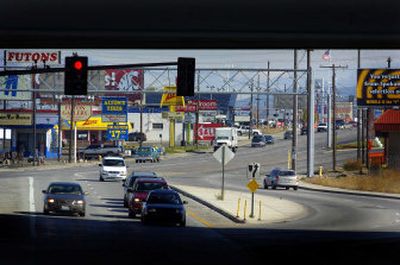Long, winding road

After years of expensive studies and extensive planning, the completion of the Sprague-Appleway couplet is still a long way off. Shoulder-high weeds and clumps of small trees cover parts of the four-mile stretch of former railroad right of way between University and East Appleway that Spokane County bought in 1980. Piles of lawn clippings and scrap lumber sit on the opening that offers an almost unobstructed view of the mountains that surround Liberty Lake. “It’s kind of in the shadows,” Councilman Gary Schimmels said of the project recently. “You can’t just go out and build it because we don’t have the money.”
The state set aside $4.2 million for the undertaking but won’t give it to the city until the project is included in a regional transportation plan written by the Spokane Regional Transportation Council.
In May 2004 the city asked that money be added to a $250,000 federal grant spent on an environmental study for the project that started before the city’s incorporation. The additional funds were needed to pay for updating the document, according to the minutes of an SRTC committee meeting.
City engineers hope to complete required studies on the project by the end of the year.
“The thing that has been holding the project up the most has been our concerns with the regional (traffic) model,” Spokane Valley’s senior engineer Steve Worley said.
Included in the analysis of the project’s impact are computer-generated models of how traffic flows through the Valley.
Calculations generated by SRTC showed traffic patterns that varied significantly from traffic counts city engineers were looking at.
“We’ve been working to figure out why the models have been doing that,” Worley said.
The accuracy of the modeling is crucial because Spokane Valley has to prove that there is a need for more traffic capacity along the route before the project can be approved for the regional plan and the state money.
Once road deficiencies are found, municipalities have to look at improving existing roadways and alternative forms of travel before they can spend grant money on new roads for single-occupant vehicles, said SRTC transportation manager Glenn Miles.
A state deadline to submit an environmental study passed last December. The state’s Transportation Improvement Board, which allocates the road grants, gave the city an extension until next July.
“We try to give them plenty of time,” said Steve Gorcester, TIB executive director.
As for the first phase of Appleway construction between University and Evergreen, “We don’t anticipate starting until 2007,” said Councilman Rich Munson.
“We do feel that we’ve really got to get this going,” he said.
The County Commission and the Spokane Valley City Council only recently finished joint talks on handing over the right of way to the city, which Munson said has been one of the biggest delays for the project.
County and city lawyers are fine-tuning the document that will transfer the land. It will then go to each governing body for approval.
In the city’s six-year transportation plan, construction for the final phase between Evergreen and East Appleway is scheduled to begin in 2009.
Meanwhile, some property owners are still wondering what will become of the former railroad property next to their land.
“Our frustration is ‘Let’s get going on this,’ ” said Jerry Quinn, who headed a group that pushed last year for the couplet’s completion.
If and where the road is one-way and how it is built will greatly affect the traffic that businesses rely on, business owners say.
“A lot of people are waiting on that decision,” Quinn said.